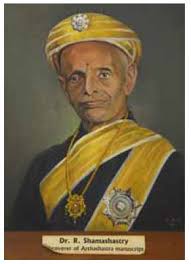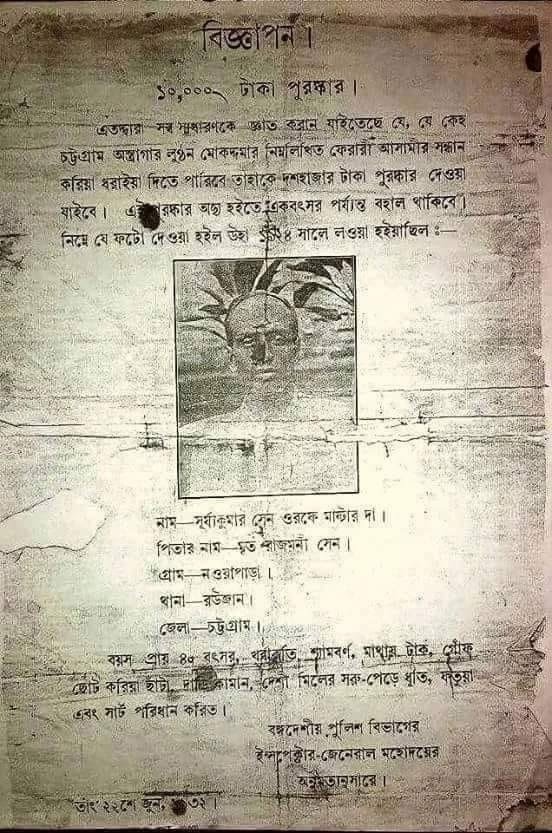#LegendsOfBharath
#RudrapatnamShamashastry –
The #Mahamahopadyaya who discovered Chanakya’s Arthashastra.
On his Jayanti a tribute to the legendary #Kannadiga who proved Bharatiya Civilization had robust Ancient Political & Economic policy & not copied from Greek as Europeans



#RudrapatnamShamashastry –
The #Mahamahopadyaya who discovered Chanakya’s Arthashastra.
On his Jayanti a tribute to the legendary #Kannadiga who proved Bharatiya Civilization had robust Ancient Political & Economic policy & not copied from Greek as Europeans




claimed.
R Shamashastry’s modern translation of Arthashastra is a prescribed text at Harvard, Yale and Oxford for students of Political Science, International Relations and Economics today.
Until this discovery, the Arthashastra was known only through references to it in works,
R Shamashastry’s modern translation of Arthashastra is a prescribed text at Harvard, Yale and Oxford for students of Political Science, International Relations and Economics today.
Until this discovery, the Arthashastra was known only through references to it in works,
including those by Dandin, Bana, Vishnusarma, Mallinathasuri, Megasthenes, as well as others. This discovery was "an epoch-making event in the history of the study of ancient Indian polity".
It altered the perception of Ancient Bharath and changed the course of history studies,
It altered the perception of Ancient Bharath and changed the course of history studies,
notably the false belief of European scholars at the time that Indians learnt the art of administration from the Greeks.
Shamasastry received a Ph.D Citation from Oriental University of Washington in 1919 and the Campbell Memorial Gold Medal from the Royal Asiatic Society,
Shamasastry received a Ph.D Citation from Oriental University of Washington in 1919 and the Campbell Memorial Gold Medal from the Royal Asiatic Society,
Mumbai Chapter, in 1921. Krishna Raja Wadiyar IV conferred on him the title “Arthashastra Visharada” in 1926 while the Viceroy and the Governor General of India conferred the title “Mahamahopadyaya” in 1930.
Bharatha Dharma Mahamandali (Varanasi) conferred the titles
Bharatha Dharma Mahamandali (Varanasi) conferred the titles
“Vidyalankara” in 1924 and “Panditaraja” in 1935.
An often-told anecdote involves the visit of the then-king of Mysore, Krishna Raja Wadiyar IV, to Germany. When introduced as the king of Mysore, he was asked by the vice-chancellor of a German university whether he was from the
An often-told anecdote involves the visit of the then-king of Mysore, Krishna Raja Wadiyar IV, to Germany. When introduced as the king of Mysore, he was asked by the vice-chancellor of a German university whether he was from the
Mysore of Shamasastry.
On his return, the king honoured Shamasastry and said "In Mysore we are the Maharaja and you are our subject, but in Germany, you are the master and people recognise us by your name and fame."
Born on 12th January 1868 at Basavapatna, to parents
On his return, the king honoured Shamasastry and said "In Mysore we are the Maharaja and you are our subject, but in Germany, you are the master and people recognise us by your name and fame."
Born on 12th January 1868 at Basavapatna, to parents
Venkataramaiah & Puttamma.
At the age of 13, he came to Mysuru to study under Pt. Kallikote Sastry. He later joined Maharaja Sanskrit Patashala to pursue vidwat course, graduated in 1891.
The then Dewan K. Seshadri Iyer became a patron to Shamasastry and provided accommodation
At the age of 13, he came to Mysuru to study under Pt. Kallikote Sastry. He later joined Maharaja Sanskrit Patashala to pursue vidwat course, graduated in 1891.
The then Dewan K. Seshadri Iyer became a patron to Shamasastry and provided accommodation
food to the budding scholar. His only duty was to read scriptures to the Dewan’s mother. He was sent to Central College, Bengaluru, to study English, Sanskrit & Physics at the UG level. He obtained a B. A. with distinction from Madras University in 1899. On recommendation of the
Dewan, he was appointed as a Librarian at the Oriental Library (Oriental Research Institute) in charge of editing their publications.
During this period, Shamasastry was requested to catalogue the rare manuscripts, palm leaf texts of the Library. Many years ago, a Tanjore Pandit
During this period, Shamasastry was requested to catalogue the rare manuscripts, palm leaf texts of the Library. Many years ago, a Tanjore Pandit
had gifted a rare palm leaf text to the Library. Till then, scholars had assumed that the great treatise “Arthashastra” written by Kautilya as being lost. Shamasastry discovered this rare text in a nook of the Library with commentary by Bhatta Swamy. It electrified the world of
scholars & “Shamasastry & Mysuru” became famous overnight.
Shamasastry was unable to decipher the script even after three months of its discovery. One night, in his dream, the key to the text was revealed. He could later read the Granthi Script and translate it.
He transcribed
Shamasastry was unable to decipher the script even after three months of its discovery. One night, in his dream, the key to the text was revealed. He could later read the Granthi Script and translate it.
He transcribed
edited and published the Sanskrit edition in 1909. He proceeded to translate it into English, publishing it in 1915 with an introduction by Dr. Fleet, the renowned Indologist. His introduction heralded to the world the discovery and translation of such a magnificent piece of
work and credited Shamasastry for having accomplished such a grand endeavour. Though there are numerous translations of the Arthashastra since then, it is Shamasastry who deserves laurels for bringing it to the public notice to begin with.
Apart from discovering Kautilya's
Apart from discovering Kautilya's
Arthashastra, Sastry authored 7 books, contributed 100s of articles in various journals, he pursued his research in the Vedic era & Vedic astronomy, making valuable contributions to Vedic studies.
Calcutta University honoured Shamasastry with an honorary doctorate in the year
Calcutta University honoured Shamasastry with an honorary doctorate in the year
1920. Upon invitation from the then VC of Calcutta Uni Sir Asutosh Mookerjee, Sastry delivered 10 lectures on “Evolution of the Indian Polity.” These were later brought forth as a book in 1920.
Shamashastry had such high regards towards Mookerjhee that Sastry named his house
Shamashastry had such high regards towards Mookerjhee that Sastry named his house

in Mysuru as “Asutosh” and spent his last years here. He lived till the age of 77 years and breathed his last on 23rd January 1944. With his passing away, a glorious and remarkable chapter in the history of traditional scholars of Mysuru came to an end. A flood of condolence
letters made their way to “Asutosh” from across the world.
It is sincerely hoped that Rudrapatna Mahamahopadyaya Arthashastra-Visharada Vidyalankara Panditaraja Shamasastry’s erudition, scholarship and command will be emulated by present day scholars and students.
#VANDEMATARAM
It is sincerely hoped that Rudrapatna Mahamahopadyaya Arthashastra-Visharada Vidyalankara Panditaraja Shamasastry’s erudition, scholarship and command will be emulated by present day scholars and students.
#VANDEMATARAM
• • •
Missing some Tweet in this thread? You can try to
force a refresh





















